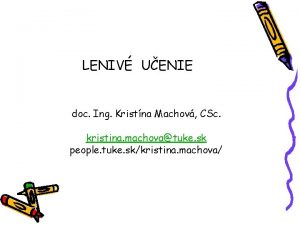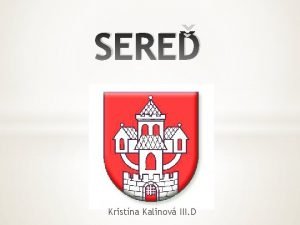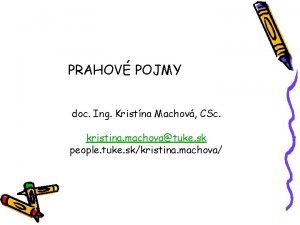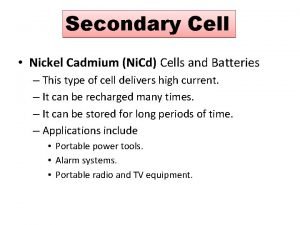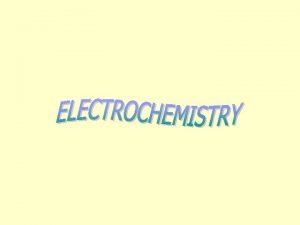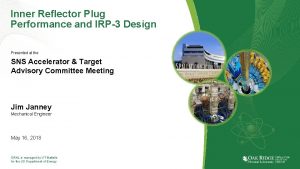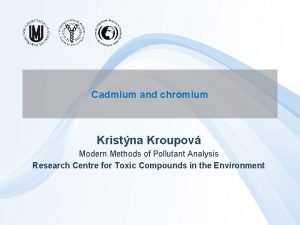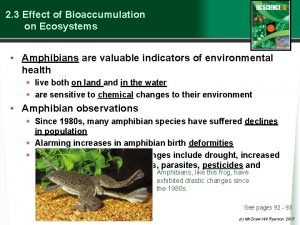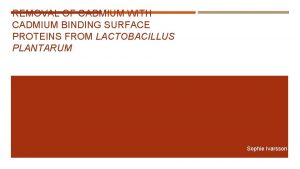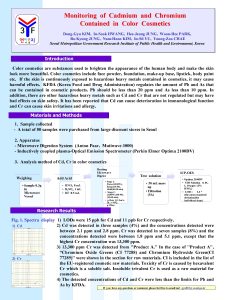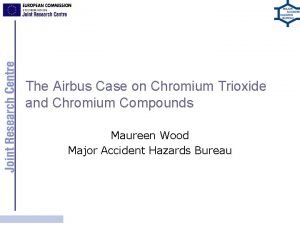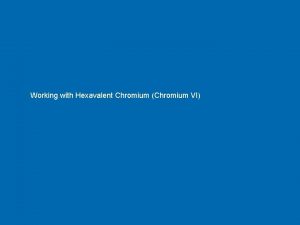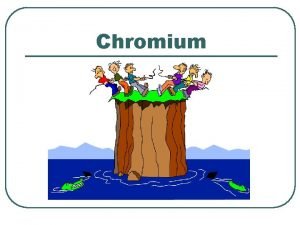Cadmium and chromium Kristna Kroupov Modern Methods of








- Slides: 8

Cadmium and chromium Kristýna Kroupová Modern Methods of Pollutant Analysis Research Centre for Toxic Compounds in the Environment

Outline • • • Cadmium and chromium in the environment Compounds and human exposure Toxicity Methods Legislation Summary 2

Cd and Cr in the environment • • • Naturally in Earth's crust Natural sources: Volcanic eruptions, erosion Anthropogenic sources: – mining, industrial wastes, coal combustion, chemical industry, fossil fuels, transportation, fertilisers Cadmium – Application: • Batteries (Ni-Cd) • Electroplating • Pigments: Cadmium yellow, cadmium red, cadmium orange Chromium – Application: • stainless steel • Electroplating • Dyes and pigments – Chrome yellow, green – Chromium oxide (green) – main ingredient in infrared reflecting paints • Wood preservative • Tanning (leather) • Catalyst (polyethylene production, water gas shift reaction, hydrogenation) 3

Compounds and human exposure Cadmium Chromium Compounds: oxidation states from –II to +VI. Rare in pure state in nature Mostly in oxidation state II+ Inorganic salts Organic compound • microbial formation of monomethyl cadmium (significance not know) Main sources of human exposure: • Eating, drinking, smoking, dust breathing Retains in kidney and liver Cr. III and VI+ are relevant. Cr. II, IV+, V+ - short lifetime, Cr. O 2 nontoxic Main sources of human exposure: • • • Eating, drinking: Higher concentrations in food from stainless steel cans. Dust breathing – small amounts, smoking Household goods: wood preservatives, cement, textiles, leather products. Retains mostly in kidneys and lungs. Cr. III unable to cross cell membrane Cr. IV cross cell membranes through phosphate and sulfate anion-exchange carrier pathway. Biological half-life: 10 – 30 years Biological half-life: varies from 15 days to 5 Excretion: urine, hair, nails, breast milk years (depend on form) Excretion: urine, breast milk, hair, nails 4

Toxicity Cadmium Chromium • • • Cr. III essential for mammal's metabolism Cr. VI: Toxic • irritation of upper respiratory tract and skin • nose bleeding • ulceration • kidney and liver problems • imunotoxic, neurotoxic • IARC carcinogen (Group 1) only Cr. VI renal dysfunction Long/high exposure – renal failure Bone demineralization - osteoporosis Neurotoxic, genotoxic, teratogenic IARC carcinogen (Group 1) – – Lung Endometrium Bladder Breast – Lung – Upper respiratory tract • Lack of appropriate data on effect of chromium during lactation. 5

Methods Cadmium Chromium Total Cd: ICP-MS, ET-AAS, GF-AAS… Cd speciation: 1. Separation: Total Cr: UV/VIS photometry, AAS, ICP-MS Cr speciation: – Gel permeation chromatography, – Anion-exchange chromatography – HPLC 1. separation of species: ion pair chromatography 2. Detection: UV/VIS photometry, AAS, ICPMS, chemiluminiscence methods… 2. Detection: – AAS – ICP-MS – Voltametry Speciation: Liquid samples – „easy“ to analyze Solid samples – analytical challenge (for transformation of a solid sample into a liquid state extraction procedure has to be applied -> risk of species conversion) 6

Legislation Cadmium – limits Chromium limit Emission 0, 05 mg/m 3 Imission (PM 10), year average 5 ng/m 3 Water (for babies, surface water, waste water…) 5 ug/l – 0, 2 mg/l Soil (different type) 0, 04 – 800 mg/kg (dry mater) Food (different type) 0, 05 – 1, 0 mg/kg Commission Regulation (EC) No 1881/2006 Toys Directive 2009/48/EC of the European Parliament Many more… Emission (suma of metals As, Co, Ni, Se, Tl, Cr) 2 mg/m 3 imission - Water 0, 025 – 0, 5 mg/l Soil 0, 29 – 90 mg/kg (dry mater) Food 0, 2 – 4, 0 mg/kg … Convention on Long-Range Transboundary Air Pollution (CLRTAP): Protocol on Heavy Metals (1998) - The protocol addresses the reduction of cadmium, lead and mercury emissions 7

Summary ✓ Presence of Cd and Cr in wide range of matrices – possible sources of human exposure ✓ Toxicology data available (gaps – effects in small doses and mixtures) ✓ Methods (mostly for total concentrations, speciation of Cd and Cr is hard to perform) ✓ Legislation Future plan: • Methods for speciation in solid samples (Cr) • Methods for speciation Cd and Cr in complex matrixes (content of fat and protein e. g. human tissues – milk, blood, muscles…) • Evaluation of effect during lactation (Cr) • Evaluation of effect in low doses and mixtures 8
